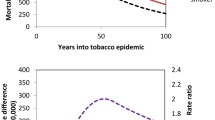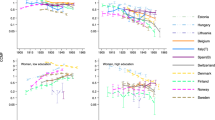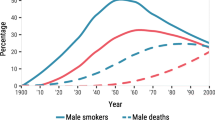Abstract
Declines in mortality rates for females at older ages in some developed countries, including the United States, have slowed in recent decades even as decreases have steadily continued in some other countries. This study presents a modified version of the indirect Peto-Lopez method, which uses lung cancer mortality rates as a proxy for smoking exposure, to analyze this trend. The modified method estimates smoking-attributable mortality for more-specific age groups than does the Peto-Lopez method. An adjustment factor is also introduced to account for low mortality in the indirect method’s study population. These modifications are shown to be useful specifically in the estimation of deaths attributable to smoking for females at older ages, and in the estimation of smoking-attributable mortality more generally. In a comparison made between the United States and France with the modified method, smoking is found to be responsible for approximately one-half the difference in life expectancy for females at age 65.





Similar content being viewed by others
References
Brønnum-Hansen, H., & Juel, K. (2000). Estimating mortality due to cigarette smoking: Two methods, same result. Epidemiology, 11, 422–426.
Centers for Disease Control and Prevention (CDC). (2005). Annual smoking-attributable mortality, years of potential life lost, and economic costs—United States, 1997–2001. Morbidity and Mortality Weekly Report, 54, 625–628.
Centers for Disease Control and Prevention (CDC). (2008). Smoking-attributable mortality, years of potential life lost, and productivity losses—United States, 2000–2004. Morbidity and Mortality Weekly Report, 57, 1226–1228.
Department of Health and Human Services (DHHS). (2000). Healthy people 2010 (2nd ed.). Washington, DC: U.S. Department of Health and Human Services.
Ezzati, M., & Lopez, A. D. (2003). Estimates of global mortality attributable to smoking in 2000. Lancet, 362, 847–852.
Ezzati, M., Lopez, A. D., Rodgers, A., Hoorn, S. V., & Murray, C. J. L. (2002). Selected major risk factors and global and regional burden of disease. Lancet, 360, 1347–1360.
Forey, B., Hamling, J., Lee, P., & Wald, N. (2002). International smoking statistics (2nd ed.). New York: Oxford University Press.
Janssen, F., Kunst, A., & Mackenbach, J. (2007). Variations in the pace of old-age mortality decline in seven European countries, 1950–1999: The role of smoking and other factors earlier in life. European Journal of Population, 23, 171–188.
Janssen, F., Mackenbach, J. P., & Kunst, A. E. (2004). Trends in old-age mortality in seven European countries, 1950–1999. Journal of Clinical Epidemiology, 57, 203–216.
Kahn, H. A., & Sempos, C. T. (1989). Statistical methods in epidemiology. New York: Oxford University Press.
Kircher, T., Nelson, J., & Burdo, H. (1985). The autopsy as a measure of accuracy of the death certificate. The New England Journal of Medicine, 313, 1263–1269.
Lopez, A. D. (1993). On the assessment of smoking-attributable mortality. In Proceedings of the International Population Conference (Vol. 1, pp. 449–58). Liege, Belgium: International Union for the Scientific Study of Population.
Malarcher, A. M., Schulman, J., Epstein, L. A., Thun, M. J., Mowery, P., Pierce, B., . . . , Giovino, G. A. (2000). Methodological issues in estimating smoking-attributable mortality in the United States. American Journal of Epidemiology, 152, 573–84.
Meslé, F., & Vallin, J. (2006). Diverging trends in female old-age mortality: The United States and the Netherlands versus France and Japan. Population and Development Review, 32, 123–145.
National Center for Health Statistics (NCHS). (2009). National Health Interview Survey. Retrieved from http://www.cdc.gov/nchs/nhis.htm
Nusselder, W. J., & Mackenbach, J. P. (2000). Lack of improvement in life expectancy at advanced ages in the Netherlands. International Journal of Epidemiology, 29, 140–148.
Pampel, F. C. (2002). Cigarette use and the narrowing sex differential in mortality. Population and Development Review, 28, 77–104.
Pampel, F. C. (2005). Forecasting sex differences in mortality in high income nations: The contribution of smoking. Demographic Research, 13, article 18, 455–484. doi:10.4054/DemRes.2005.13.18
Peto, R., Lopez, A. D., Boreham, J., & Thun, M. J. (1994). Mortality from smoking in developed countries, 1950–2000: Indirect estimates from national statistics. New York: Oxford University Press.
Peto, R., Lopez, A. D., Boreham, J., & Thun, M. J. (2006). Mortality from smoking in developed countries, 1950–2000 (2nd ed.). Oxford, UK: Oxford University. Retrieved from http://www.ctsu.ox.ac.uk/~tobacco
Peto, R., Lopez, A. D., Boreham, J., Thun, M. J., & Heath, C. (1992). Mortality from tobacco in developed countries: Indirect estimation from national vital statistics. Lancet, 339, 1268–1278.
Preston, S. H., & Wang, H. (2006). Sex mortality differences in the United States: The role of cohort smoking patterns. Demography, 43, 631–646.
Rogers, R. G., Hummer, R. A., Krueger, P. M., & Pampel, F. C. (2005). Mortality attributable to cigarette smoking in the United States. Population and Development Review, 31, 259–292.
Sterling, T. D., Rosenbaum, W. L., & Weinkam, J. J. (1993). Risk attribution and tobacco-related deaths. American Journal of Epidemiology, 138, 128–139.
Thun, M. J., Henley, S. J., Burns, D., Jemal, A., Shanks, T. G., & Calle, E. E. (2006). Lung cancer death rates in lifelong nonsmokers. Journal of the National Cancer Institute, 98, 691–699.
University of California, Berkeley and Max Planck Institute for Demographic Research (UCB-MPIDR). (2009). Human Mortality Database. Retrieved from at http://www.mortality.org
Valkonen, T., & van Poppel, F. (1997). The contribution of smoking to sex differences in life expectancy: Four Nordic countries and the Netherlands, 1970–1989. European Journal of Public Health, 7, 302–310.
World Health Organization (WHO). (2009). WHO Mortality Database. Retrieved from http://www.who.int/whosis/mort/download/en/index.html
Acknowledgments
The authors would like to thank Ron Lee, Ken Wachter, and Griff Feeney for helpful suggestions and comments. The authors are also grateful for support for this research from the National Institute of Aging (Grant Nos. T32 AG000246-14 and R01 AG11552).
Author information
Authors and Affiliations
Corresponding author
Rights and permissions
About this article
Cite this article
Rostron, B.L., Wilmoth, J.R. Estimating the Effect of Smoking on Slowdowns in Mortality Declines in Developed Countries. Demography 48, 461–479 (2011). https://doi.org/10.1007/s13524-011-0020-9
Published:
Issue Date:
DOI: https://doi.org/10.1007/s13524-011-0020-9




